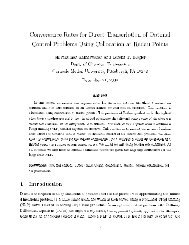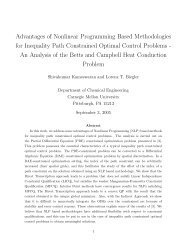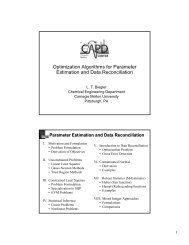MPEC Problem Formulations in Chemical Engineering Applications
MPEC Problem Formulations in Chemical Engineering Applications
MPEC Problem Formulations in Chemical Engineering Applications
Create successful ePaper yourself
Turn your PDF publications into a flip-book with our unique Google optimized e-Paper software.
4.1 Automatic Reformulation of ComplementarityMPCC models written <strong>in</strong> the GAMS model<strong>in</strong>g language may be automaticallyreformulated as an NLP us<strong>in</strong>g several of the previously described complementaritysolution techniques. This can be accomplished with the use of the NLPECmeta-solver [8]. When called, NLPEC reformulates the complementarity constra<strong>in</strong>tsof a MPCC model with a user specified reformulation, <strong>in</strong>clud<strong>in</strong>g (17)-(20). NLPEC will then call a user-specified NLP solver to solve the reformulatedmodel. The f<strong>in</strong>al results from the NLP solver are then translated back <strong>in</strong>to theorig<strong>in</strong>al MPCC model. NLPEC verifies that the complementarities are satisfied<strong>in</strong> the result<strong>in</strong>g solution. This is particularly important when us<strong>in</strong>g the PF(ρ)formulation described above, as it may not converge to a stationary po<strong>in</strong>t of theMPCC if the penalty parameter is too small.4.2 Comparison of Solution Strategies on <strong>MPEC</strong>Lib<strong>MPEC</strong>Lib is a set of <strong>MPEC</strong> test problems ma<strong>in</strong>ta<strong>in</strong>ed by Dirkse [19]. The testset currently consists of 92 problems, which <strong>in</strong>clude both small scale modelsfrom the literature and several large <strong>in</strong>dustrial models.The performance and robustness of several NLP reformulations <strong>in</strong>clud<strong>in</strong>gPF(ρ) with ρ = 10, Reg(ǫ) with ǫ = 10 −8 , and NCP formulation x T y = 0,x, y ≥ 0 were compared on the <strong>MPEC</strong>Lib test set. CONOPT (version 3.14) andIPOPT (version 3.2.3) were used to the solve the result<strong>in</strong>g NLP problems. Allreformulations were performed automatically by the NLPEC solver describedearlier. Also <strong>in</strong>cluded <strong>in</strong> the comparison is the IPOPT-C solver, which is capableof process<strong>in</strong>g the complementarity constra<strong>in</strong>ts without reformulation. TheCONOPT and IPOPT runs were performed entirely with<strong>in</strong> the GAMS environment.However, IPOPT-C is not currently l<strong>in</strong>ked to GAMS. In order toperform the tests with IPOPT-C, the GAMS models were <strong>in</strong>stead convertedto the AMPL model<strong>in</strong>g language format. The problems were then run us<strong>in</strong>gAMPL and IPOPT-C.The results are presented <strong>in</strong> a Dolan-Morè plot. All results were obta<strong>in</strong>ed ona Intel Pentium 4, 1.8 GHz computer with 992 MB of RAM. This plot portraysboth robustness and relative performance of a set of solvers on a given problemset. Here we def<strong>in</strong>e a performance ratio calculated as:η p,s =t p,sm<strong>in</strong> {t p,s : 1 ≤ s ≤ n s }(23)where n s is the number of solvers, which are run over the n p problems <strong>in</strong> set P,and where t p,s is the solution time for solver s on problem p. For all solvers sthat fail to solve problem p, we set the performance ratio to an arbitrarily largenumber. The profiles are then def<strong>in</strong>ed by:p s (τ) = 1 n psize {p ∈ P : η p,s ≤ τ} (24)10






